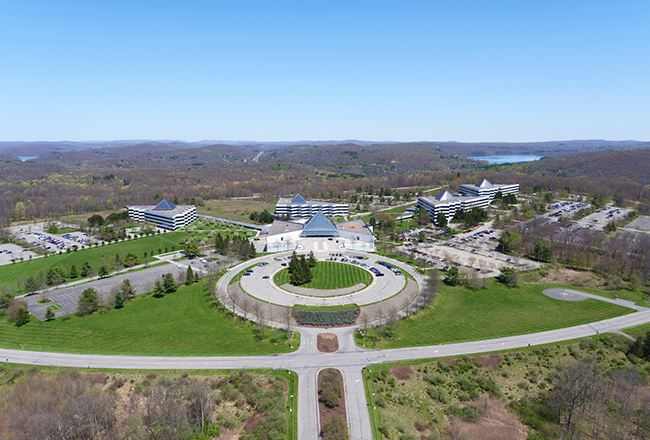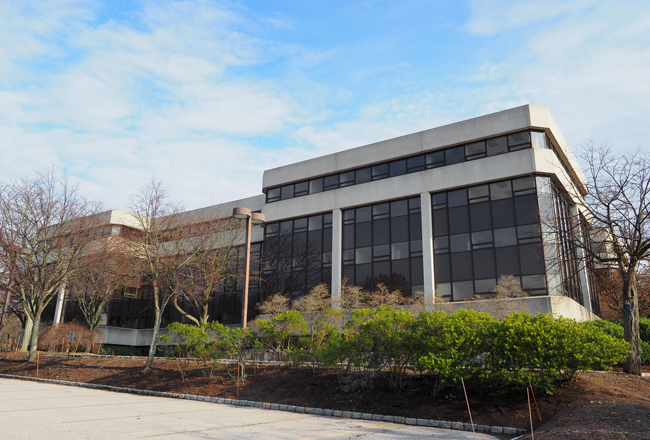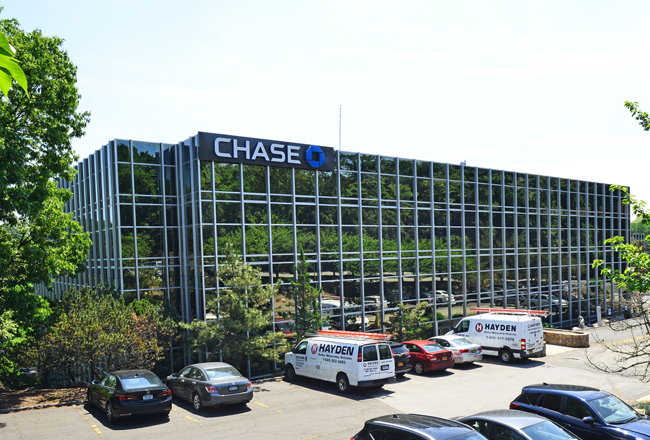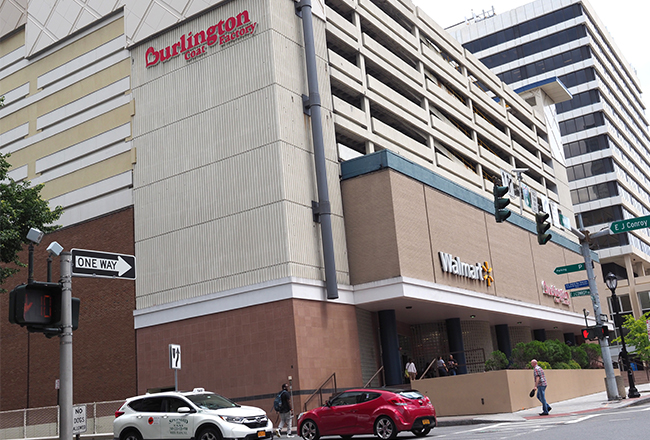The Westchester County office market moved forward on two fronts during 2018. The first was a continuation of the positive absorption trend. The second was the continued demolition or repurposing of existing buildings.
We ended 2018 with 160,000 square feet of positive absorption, even though the fourth quarter had more than 130,000 square feet of negative absorption (due primarily to 100,000 square feet of space being returned to the market by Verizon shrinking at The Summit in Valhalla). This was the first time in nine quarters that the county had negative absorption. Down county there are fewer spaces available than there have been in years.
These are good signs for the market. Suburban rental rates are moving up slightly. And we continue to take inventory off the market. In the last decade or so, our multitenant office market has shrunk from about 32 million square feet to about 27.6 million square feet through repurposings and demolition of obsolete office buildings. If we cannot increase demand, decreasing supply will help to keep the market healthy. We are not done yet. Repurposings and demolitions look to continue in 2019. When you consider that our newest office product dates from the mid-’80s, it is clear that many buildings have reached the end of their useful life.
Total leases signed (leasing velocity) reached 1.7 million square feet last year compared with 2.1 million square feet in 2017. The county”™s availability rate ended the year at 21.6 percent, a half point above the third quarter”™s 21.1 percent, but about a half point less than 2017”™s final number. We had only one lease deal over 100,000 square feet (a renewal/expansion by Fuji at The Summit in Valhalla), and only five leases of more than 25,000 square feet for about 267,000 square feet. There were no deals between 50,000 and 100,000 square feet. A typical year has about 16 deals over 25,000 square feet, totaling about 800,000 square feet, according to Karolina Alexandre, research manager at Newmark Knight Frank.
Square footage in deals between 10,000 and 25,000 square feet increased by 40 percent over 2017 (40 deals totaling 600,000 square feet in 2018 compared with 27 deals totaling 430,000 square feet in 2017).
Deals between 5,000 and 10,000 square feet totaled 352,000 square feet in 50 deals in 2018 against 300,000 square feet in 44 deals the previous year.
The historically most popular small-deal category (below 5,000 square feet) featured 206 deals totaling 472,000 square feet in 2018 compared to 2017”™s 180 deals totaling 432,000 square feet.
And these numbers were done in an environment where there is a dearth of quality space available in the market.
Let”™s not forget that the northern submarket continues to drag down the overall market. With the former IBM Somers campus (1.2 million square feet), the former Pepsi Bottling building (540,000 square feet) and the former MBIA headquarters (287,000 square feet), there is more than 2 million square feet sitting vacant in the north.
I represent many tenant clients and I represent buildings with space to lease. I know from my own activity and talking to building leasing agents that they are all busy showing space. Many times there is more than one tenant negotiating on a particular space. In the brokerage community, there is a general optimism and a consensus that our office market is turning from a pure tenant”™s market toward a landlord”™s market. We are certainly not there yet, but it is a much more balanced market in which both tenants and landlords have similar bargaining power.
Tenant expansions significantly outnumber tenant downsizings. Our inventory of office space continues to shrink. Between repurposings to other uses and demolition of functionally obsolete office buildings, our overall market has shrunk from about 32 million square feet to about 27.6 million square feet during the last decade or so.
As I research available spaces for my tenant clients, I find there is a dearth of “quality spaces.” This would refer to spaces that do not have sufficient window line for the size of the space, or spaces that are oddly configured, or that do not have a prominent entry, have poor views, among other issues. As buildings get re-leased, the most desirable spaces go first and the later tenants have less desirable choices. The flex and industrial markets are extremely tight with very little inventory, significant increases in rental rates and little if any chance of additional inventory being developed in Westchester.
Alexandre has been my go-to source for market statistics for my articles for many years, including all the statistics quoted in this article. She has a spot-on theory about how changes in employment trends have had a major impact in our office market.
“In the past, employees followed employers,” she said. “That meant that IBM could build its headquarters in Armonk and a large office campus in Somers and employees would flock to fill them. The same held true with the Reader”™s Digest headquarters in Chappaqua, the former Pepsi Bottling building in Somers and many other corporate headquarters and offices. In today”™s world, that rule has been turned upside down and employers are striving to locate their offices in places that employees want to work. This in large part explains why over 2 million square feet of empty office space is languishing in our northern submarket. If these spaces were magically leased or otherwise removed from the inventory, our current availability rate would plummet from 21.6 percent to 15.4 percent, which is a much more accurate reflection of the health of the Westchester office market.”
Expansions have outnumbered downsizings by about 4 to 1. We have seen some organic growth as well as some companies opening new offices or relocating to Westchester.
Fourth-quarter leasing was approximately 500,000 square feet, up more than 17 percent from the fourth quarter of 2017 and up 16.5 percent from the third quarter of 2018.
Notwithstanding the large amount of vacant space in the northern submarket, the lower portion of the county has seen a significant tightening over the last two years.
HOPE IN THE NORTHERN SUBMARKET

In September there was a media report stating that a tenant had interest in leasing the entire 1.2 million-square-foot former IBM campus in Somers for a private STEM (science, technology, engineering and math) school. Not only was this for-profit tenant going to lease the entire campus, but construct additional buildings as well. The prospective tenant and its land-use consultants went before Somers officials and presented the plan, but there has been no further word since then about whether or not it will move forward. The owner of the former IBM campus (Mexican billionaire Carlos Slim, who is reportedly also a partner in the school) has removed the campus from the real estate listings of available space. If this project does go forward, it will reduce the overall Westchester office vacancy rate significantly.
RENTS ARE INCREASING IN THE WHITE PLAINS CBD

With a number of large leases during 2017 in the White Plains Central Business District (CBD), we are seeing a very significant disparity in occupancy costs between the CBD and suburban buildings. Lease deals in Class A buildings in the CBD are starting in the mid-$30s per square foot, escalating over the lease term. Asking rental rates in the area near the Metro-North station in the CBD have gone up more than $3 per square foot in the last two years (almost 10 percent), while asking rents in the suburban submarkets are just beginning to float up a bit from mid-1980s levels.
We are now seeing multiple buildings in the CBD asking $40 per square foot, and City Square space is listed at $43. This is major rent growth for Westchester and higher than I have ever seen. CBD parking rates are going up as well, adding about $3.50 per square foot to the occupancy cost. CBD rent plus parking and electric are now in the low to high $40s per square foot. Suburban buildings are still in the mid $20s per square foot, plus electric, with no parking cost. So they will be in the high $20s all in. We have never seen this amount of disparity between submarkets and it reaffirms the health of the White Plains CBD market.
Some law firms, including Danziger & Markhoff and Gaines, Novick, Ponzini, Cossu & Venditti, moved to 1133 Westchester Ave. last year from downtown White Plains. Given this new cost dynamic, I believe that other CBD tenants will likely look seriously at the suburban markets before they make a decision to renew their leases. It is interesting that some law firms or companies want to shed the expense of being in the CBD, along with the cost and complications of parking for both employees and clients. Other companies are migrating back to the CBD, as their employees want to be able to walk to restaurants, retail, bars and the Metro-North station. Two examples of the latter trend are Danone and Carl Zeiss, which is decamping from its own building in Valhalla to a 25,000-square-foot space at One North Broadway.
Some new blocks of space have become available. There is a full floor (about 30,000 square feet) at Reckson”™s 360 Hamilton that has been on the short-term sublease market for years. Now ownership is advertising it as a direct space. Other spaces that are coming available in the CBD for various reasons are now being looked at as opportunities in what is a very tight market. This is evidence of a healthy market as the owners are confident that they will re-lease these spaces at significantly higher prices than they were leased at before. As a significant amount of office space at City Square is being converted to residential, and leasing has been strong at White Plains Plaza and other CBD buildings, owners actually need some new inventory to accommodate the needs of existing tenants and to keep the leasing momentum going.
Serendipity Labs, a co-working tenant, announced that it is leasing approximately 25,000 square feet at 44 S. Broadway. While Westchester has a plethora of traditional shared-office tenants (Regus, Stark and Carr to name a few), this is the first significant co-working tenant to commit. Serendipity has more than 30 locations throughout the U.S. and has many more in the development pipeline. When this site opens, I believe it will quickly show whether this model (which includes full-time offices, part-time memberships, drop-in memberships and enterprise spaces that are essentially corporate office space that is managed by Serendipity) will have traction in Westchester. We don”™t seem to be big enough for WeWork, Knotel and other New York City-centric co-working tenants to be interested in us.
THE EAST SIDE: NEW RESIDENTIAL, RETAIL AND MEDICAL

Normandy Partners bought 14 multitenant buildings (most of the former Schulman portfolio) in 2009. This was the bulk of the multitenant inventory on the I-287 East corridor. As of this writing, it owns seven of those buildings. Five buildings (totaling over 400,000 square feet of office space) have been demolished to make way for a new 125,000-square-foot Wegman”™s supermarket and Toll Brothers”™ new 420-unit multifamily development, both of which are under construction.
It was recently announced that Simone Development had purchased 104 Corporate Park Drive and already had a deal in place with Montefiore Hospital to lease the entire building for a pediatric care center. This shows that there is still demand for large medical facilities and building owners and large institutional tenants now need to be more creative to fill these requirements. There are very few large blocks of office space available on the 287 corridor and in the county in general south of Armonk.
The office building at 3 Westchester Park Drive has seen its last tenant depart, and the new owner will demolish this 160,000-square-foot office building and construct two new highly amenitized rental apartment buildings. This site is still pursuing its approvals with the town of Harrison so it has not been taken off the availability rolls. Westchester”™s largest law firm Wilson Elser vacated approximately 135,000 square feet at this building in 2012. As a result, the owner subsequently defaulted on its mortgage and the building went back to its lender.
With this new project, Westchester Park Drive will have all of the live/work/play elements. The new apartments, two existing office buildings and the 210,000-square-foot LifeTime Fitness are all within walking distance of each other. And neighboring Corporate Park Drive will contain a hotel, multifamily residential, office, medical and the new Wegman”™s supermarket. About five years ago, the majority of the office buildings in these parks were mostly, if not completely, empty.
With all of these obsolete office buildings being demolished, some might ask why no one is building new office buildings.
Suburban office building rents are in the mid-$20s per square foot. If developers built a new building, at today”™s land and construction costs, with all of the technology and features that tenants want, they might need to achieve rents in the high $30s or low $40s in order to make a profit. While down county demand is reasonably good today, I think there would be a relatively small subset of tenants who would choose to pay almost twice the rent per square foot to be in a new building. It would be a significant risk for a developer and our market has not yet reached the point that would make it a good bet.

MACK-CALI EXITS WHITE PLAIN
(AND SOON THE COUNTY)
With the sale of the 571,000-square-foot Westchester Financial Center, and 1 and 3 Barker Ave., Mack-Cali is officially out of the office market in the White Plains CBD for the first time since the 1980s. Mack-Cali has cleared its One Water Street building of tenants and its Roseland subsidiary intends to demolish the building and build multifamily residential in this valuable TOD (transit-riented development) site right at the Metro-North station. This is a significant change in the market where Mack-Cali has been a major owner of office buildings since it purchased the Westchester-based Robert Martin Company inventory in 1997.
Mack-Cali”™s significantly reduced Westchester portfolio is primarily flex and warehouse space. On an earnings call, Mack-Cali”™s CEO announced that there is a sale transaction pending for all of the remaining flex parks (Yonkers, Elmsford and Hawthorne) that should close in the first half of 2019. As these large flex parks (with no debt and high rents) have been a cash cow for the REIT, no one in the brokerage community is sure why they are so eager to sell them.
Ginsburg Development is now the sole owner of the Westchester Financial Center. Very quickly after Martin Ginsburg bought the complex in partnership with the Robert Martin Company, RMC exited the deal. The three-building complex has been rebranded as City Square. Ginsburg”™s plans include making major improvements to 50 Main St. and to the Main Street streetscape with new retail and restaurants. It will also relocate some office tenants from the Martine Avenue building to the Main Street building and turn most of the Martine building into residential. This takes more office space off the inventory in the already tight CBD submarket. He has presented his plans to the City of White Plains and is awaiting approval. The new ground-floor retail space will improve what is now a dull 1980s view as most automobile commuters enter the downtown area on Main Street.
$92 MILLION IN IMPROVEMENTS
TO THE WHITE PLAINS TRAIN STATION
The MTA has been hard at work on the renovation at the White Plains station. The agency has repainted the rusting overpasses on Main Street and Hamilton Avenue and is continuing with its $92 million renovation to the third-busiest station in its system after Grand Central and Stamford.
While the MTA is moving forward, it is not clear what is happening with expressions of interest from developers for the land the city of White Plains owns adjacent to the Metro-North station. It has been a long time since the city issued RFIs (Requests for Interest) to developers in an effort to ascertain their level of interest in this large project.
A BIG TURNAROUND
ON THE WEST SIDE

Just about six months ago, it was almost impossible to do an office deal on the 119 corridor in Elmsford and Tarrytown. The former Keystone portfolio (consisting of Taxter Corporate Park in Elmsford and Talleyrand Office Park in Tarrytown) was in receivership and had no capital available to finance any renewals or new leases. Now the Tarrytown properties have been taken over by their lender who is operating them and beginning to do renewals and new deals. Local developer/owner GHP has taken over operating control of the Taxter Road buildings and is already negotiating a large medical deal at that complex. It looks like there was significant pent-up demand in the western submarket that moved into action mode as soon as the new owners were announced.
The buildings at 560 and 580 White Plains Road have been sold by RXR to a new Australian ownership entity. The new owners will recapitalize the buildings and perform major upgrades to the common areas, parking areas and landscaping. Across the street, the 555 White Plains Road building is now officially off the office inventory (another 135,000 square feet) as new owner Robert Martin Company has indicated that it will demolish the building after sole tenant Tappan Zee Constructors leaves and will replace it with other uses on that site, such as a fitness center and a self-storage facility.
Reckson/S.L. Green is another publicly traded REIT that has significantly reduced its Westchester portfolio. It sold the 115 and 117 Stevens Ave. buildings in Valhalla to GHP, and its six-building, 540,000-square-foot Reckson Executive Park in Rye Brook to George Comfort & Sons. Last year, GHP purchased 660 White Plains Road in Tarrytown from RXR. And over the past two years, Reckson/S.L. Green sold 520 White Plains Road in Tarrytown and 140/150 Grand St. in White Plains.
570 Taxter Road in Elmsford was sold by Keystone Property Group to a private partnership. Recently, RPW Group purchased 925 and 1025 Westchester Ave. from Normandy Partners. All of these buildings are seeing strong leasing activity and look like they will be fully leased very shortly. The key takeaway is that all of these building sales are at prices that are substantially below replacement cost. This gives a new owner the ability to invest capital in generally long-overdue upgrades and improvements and still be able to profit on its re-leasing of the properties at current market rents. Part of the reason that these buildings are selling so cheaply is that their owners failed to make adequate investments in them, and their leasing (and income) suffered. As soon as these buildings changed hands and were recapitalized they began leasing space again.
THE MULTIFAMILY PIPELINE
IS FULL IN WHITE PLAINS
Early in 2018 developer Lennar told White Plains city officials that its large mixed-use project on East Post Road was on hold. The country”™s largest residential developer bought the fully approved site from retail REIT Urstadt Biddle. The approvals included two large towers containing 707 apartments, and about 77,000 square feet of retail space and about 94,000 square feet of office space.
At that time Lennar indicated that it would be back to the city next year for a new site plan approval. The site, which was a former mall known as the Westchester Pavilion, has been completely demolished, so the large hole in the ground will be there for a while. But Lennar accelerated its schedule and filed new plans with White Plains during the summer. The new proposal removed the office component and significantly reduced the retail component. In their place will be additional residential units.
There will be two separate buildings rather than one large one. This will be more attractive to lenders with a lower-risk profile. And the two-phase concept will allow the developer to adjust the construction start of the second phase (or not build it) if market conditions change. Lennar has also begun demolition of the site bordered by East Post Road/Mamaroneck Avenue and Mitchell Place for its 434-unit mixed-use (residential over street-level retail) project.
Across the street, the conversion of the former Esplanade senior citizens residence to multifamily rental apartments has stalled and the property is on the market. The White Plains Mall project, named Hamilton Green, has been approved and this dilapidated structure in the middle of the CBD will be demolished as soon as it is cleared of tenants. Rose Associates from New York City has taken over the project for 440 Hamilton Ave., and is revising and expanding its plans for the site. While the former owner intended to convert the former AT&T office building to multifamily and leave the large surface parking lot behind it in place, Rose has proposed building townhouses and a parking structure on the existing parking lot, which will result in approximately twice the number of housing units contemplated by the previous developer.
The White Plains Common Council also approved The Collection, a project consisting of 25,000 square feet of retail and restaurant space and 276 apartments on Westchester Avenue, across from The Westchester mall. The functionally obsolete White Plains YMCA building on Mamaroneck Avenue near Maple Avenue is up for sale, which will ultimately be another development site.
RETAIL AND RESTAURANTS

A very large change in the retail landscape came when Walmart suddenly closed its White Plains store in August, with about two years left on its lease. While the landlord has some time to figure out the next step (reportedly Burlington Coat Factory, the only other tenant in the former Walmart building, will be moving across the street to City Center), it offers a lot of opportunities. Owner Ivy Realty is a savvy real estate player and has been very successful in its lease-up of the White Plains Plaza office complex, in great part due to a quality renovation of the parking structure and public areas. Whether the former Walmart building will continue as retail, be adapted to another use, or torn down for residential, it will be an improvement to a key site in the Central Business District.
At 235 Main St., the Chase Bank branch has closed. This second-floor space features huge windows, high ceilings and beautiful stonework. A Brazilian steak house chain has leased 13,000 square feet and is converting this classic space to a restaurant. It will have a ground-floor kitchen on Church Street, the restaurant on the second floor and mechanical space above the restaurant. The corner of Main Street and Mamaroneck Avenue now features a host of restaurants, from Serafina and Mediterraneo to BLT Steak and Morton”™s Steakhouse, as well as this new entry to the market.
HIGH-END CONDOS
National Realty and Development has reportedly sold out its first phase of waterfront condominiums on the site of the former Beckwith Pointe Beach Club in New Rochelle, which are in the beginning stages of construction. Alfred Weissman has just broken ground on his St. Regis Condominiums on the grounds of a former office building in Rye.
Construction continues on King Street at the former Reckson Executive Park (now owned by George Comfort & Sons) on high-end duplexes and free-standing homes. With many empty nesters selling multimillion dollar homes in Westchester, we need more upscale empty-nester product to keep these people in the county.
MULTIFAMILY IS HOT THROUGHOUT WESTCHESTER

Photo by Aleesia Forni.
The big acronym for multifamily residential development is TOD (transit oriented development). This refers to apartments that are within walking distance of a Metro-North station, and these are the most popular and most valuable locations in all markets today. Yonkers has a number of large projects under construction. The combination of the Hudson River and easy access to Metro-North has attracted many developers to this area. Many people are already living there and I anticipate that the new inventory will lease up as well. AMS Acquisitions recently purchased the office building at 86 Main St. (directly at the Metro-North station) and it is undergoing a significant restoration, including changing the window configuration to get better views of the river. In addition, this group has purchased the Chicken Island site adjacent to City Hall, where it plans a large mixed-use development, including a luxury hotel. They have also purchased Teutonia Hall, a site on which they will build a 24-story, 361-unit residential project. This site has remained vacant for a number of years after a previous developer remediated contamination on the site but did not proceed with construction.
New Rochelle is also seeing buildings come out of the ground. RXR”™s 28-story 587 Main St. has topped out and the curtain walls are going up. The same developer has two more 28-story residential buildings in the approval pipeline for the site of the now-demolished Church-Division parking structure. These buildings will have Long Island Sound views from their upper floors as well as a walk to the Metro-North station. Soon, commuters will be able to get to either Grand Central or Penn Station from New Rochelle, and the city also has the advantage of Acela and Amtrak services.
A number of large multifamily projects have already been approved and a number of smaller projects have been completed or are under construction. The city”™s new, simplified approval process has attracted a number of developers to the Queen City on the Sound.
Port Chester has hired a consulting firm to help its planning efforts for its downtown area. The biggest question mark in the village is who will take over the former United Hospital site now that Starwood Capital has decided not to move forward on it. This is a very large site in a key location.
There are also many smaller multifamily developments under construction or in the approval pipeline in areas, including Harrison, Pleasantville, Peekskill and others.
THE TRUTH ABOUT ALL THE MULTIFAMILY DEVELOPMENT
There are people (both in and out of the real estate industry) who are questioning whether the market can absorb the thousands of apartment units that are planned.
The median age of the apartment stock in Westchester is over 50 years. That means many of the existing units are functionally obsolete. Current apartment vacancy is less than 5 percent. These two facts alone would speak to the necessity for new inventory. Not to mention that virtually all of these projects are being built with very attractive amenity packages, including pools, common rooms, roof decks and business centers, which are very attractive to renters of all ages.
These thousands of units are at various stages in the approval/development pipeline. It can take years from the announcement of a new development for it to be approved in Westchester. Once it is approved, the construction documents need to be completed, a contractor hired and bids received and accepted from all the subcontractors. The timeline to construct a large project can range from 18 months to multiple years. These units will actually go into the leasing phase over a relatively long period of time. So far, completed projects have leased very well. Yonkers, New Rochelle and White Plains have the biggest pipelines, but many of these projects will not begin leasing for five years or more.
INDUSTRIAL KEEPS GETTING TIGHTER
The industrial and flex (office/warehouse) market keeps getting tighter and higher priced. Westchester is seeing an influx of industrial tenants that are being pushed out of areas, including Queens and the Bronx either by lack of inventory or high rental rates and sale prices, putting additional pressure on our market. Space that used to rent for $8 to $10 per square foot is now routinely asking (and getting) $15 to $18. Larger buildings with higher ceilings and good loading are commanding rents that approach suburban office rents. Never in my 30-plus years in the market have I seen this type of rent growth. The fact that there are literally no space alternatives for many tenants is part of what is keeping the rates high.
Old buildings (particularly in Yonkers and Mount Vernon) are being demolished to make way for high-rise multifamily developments and there is no way to replace them. I am confident that the escalation in pricing for this product type will only continue to increase, with the current availability rate at 4.8 percent.
The Mack-Cali flex parks will be sold for a hefty price, based on in-place income and upside potential of expiring leases. The sale of Mack-Cali”™s Warehouse Lane industrial park has closed and the buyer is a private equity investor named Realterm Logistics, which owns over 35 million square feet of industrial space in the U.S. and India in 300 properties. It paid $182 per square foot for this pure industrial property. This is far more than almost any office building sale (including the sale of the Westchester Financial Center in White Plains across from the Metro-North station at $146 per square foot) that has taken place over the last few years. It may not be pretty, but Warehouse Lane will be a money maker for years to come for its new owner. Mack-Cali said the proceeds from the sale would be used for “the transformation of its office properties in Jersey City and developing its multifamily platform on the (New Jersey) waterfront.” It certainly felt like a real estate deal to our market, but what drove this transaction was the seller”™s corporate priorities in another market.
BIG NEWS IN BIOTECH
There is very little laboratory space available in Westchester for pharma and biotech companies. Regeneron has taken every square foot at its Landmark at Eastview facility and bought the entire 1 million-plus-square-foot campus from its former owner BioMed Realty Trust. This has shut out existing tenants (some of whom have had to vacate their space) and has taken one of the few purpose-built laboratory facilities completely off the market
Regeneron has also bought a 100-acre adjacent land parcel and had it zoned to accommodate its anticipated growth. But we are pretty much a “one-company town” in biotech, as Regeneron”™s explosive growth has caused other companies with laboratory space requirements to relocate to Rockland County or New Jersey, and basically monopolized almost all of the laboratory space that we have. Laboratory space is very expensive to build and it is unlikely that we will see developers come into our market to build it without tenants in place.
So our hope lies in the North 60 project.
Biotech is a great industry in a high-cost county such as ours. It will attract big companies with big space requirements and large, highly compensated workforces.
The Business Journal reported on Jan. 10 that County Executive George Latimer and developer John Fareri signed a 99-year lease for 60 acres of county land at the Grasslands Reservation in Valhalla where Fareri intends to develop a $1.2 billion biotech project.
In addition to the 60 acres of county-owned land, Fareri Associates will use the 20 acres of adjacent land it owns for the project. The county expects to receive about $7 million in rent each year.
Fareri told the Business Journal that he expects the project will complement the Westchester Medical Center and Maria Fareri Children”™s Hospital.
Fareri said he hopes to obtain local approvals, including environmental study requirements in about 18 months and have shovels in the ground shortly thereafter. The development will be in phases, with the first phase comprising approximately 500,000 square feet. Completion of all phases could take 10 years and would result in up to 3 million square feet being developed.
It is estimated the project will create 4,000 construction jobs and 8,000 permanent jobs. In addition to laboratory and research space, medical offices and a children”™s living center, there would be a 100-room hotel.
SUMMARY
The northern submarket (7.3 million square feet) continues to be about 36 percent vacant, with little chance to change that unless the STEM school leases the entire IBM Somers campus. Normal market tenants will not take us out of this problem. This is another example of IBM having a significant negative effect on the office market, as it has since it began giving back many millions of square feet of leased space in White Plains, Tarrytown, Harrison and many other down county locations some 30 years ago. IBM, rather than new construction, has been the source of millions of square feet of inventory in our market and a very large contributor to our consistently high vacancy rates.
Of our 27.6 million-square-foot market, about 11 million square feet (consisting of the northern submarket and the 3.7-million-square-foot western submarket) was functionally or geographically “off the market” for most or all of the year.
Thirty years ago, most of Westchester”™s office space was developed and owned by local families. It was the Schulmans, the Halperns, the Bergers and Weinbergs and the Cappellis whose interests were solely Westchester-centric. Their family fortunes were tied to those of the county and they were solely focused on the county.
Today it is public REITs (Mack-Cali, S.L. Green and Empire State Realty Trust, for example) and large real estate partnerships, such as Normandy Partners, that control the vast majority of our office buildings. Their businesses span much larger geographic footprints and their decisions about acquisitions and dispositions are driven by many factors that have nothing to do with Westchester.
S.L. Green is the largest office building owner in New York City. Mack-Cali has the majority of its office portfolio in New Jersey and owns buildings in New York, Connecticut and Pennsylvania. It has diversified in a big way into the multifamily market, building rental apartments in New York, New Jersey, Massachusetts, Virginia and Washington, D.C. Local player GHP has taken advantage of dispositions and the financial distress of some office buildings in recent years, significantly increasing the quantity and quality of its portfolio. Robert Weisz”™s RPW Group and Mark Ellman”™s Celestial Capital are two more of the few private owners of Class A properties today.
RXR sold off its office portfolio in Tarrytown, but is a big player in multifamily residential in New Rochelle and Yonkers. The nation”™s largest developer, Lennar, is in the process of developing over 1,100 residential units in White Plains. And the newest entrant to our market is a large private equity investor (Realterm Logistics) that spent more money per square foot to buy old warehouse space than we sell most Class A office buildings for.
We are looking at a very different market today than in the past and we have to look at it through a different lens. Most of our office market is in a very healthy state. Our multifamily market is booming with our cities and towns receiving the benefit of major investments by large developers that will bring new residents and new tax revenues. Our flex and industrial market is red hot. The redevelopment of Westchester is well under way and gaining momentum.
























How will recently announced Con Ed natural gas moratorium on new customers impact the market from which was described in this article? It is more than likely going to have a negative impact on Westchester, making it less desirable to do business or could it drive a new energy policy for the region?
This is very recent news, and it could affect development significantly. All of the new multi-family developments will likely want to use natural gas for their heating. We will have to stay tuned to see what will happen, but one thing is clear: White Plains, Yonkers, New Rochelle and a number of other municipalities have big stakes in this, and will do their best to find a solution.